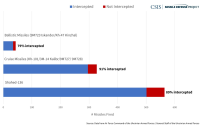China's AD is extremely weak in terms of numbers compared to US and Russia. They have just 290 total HQ-9 launchers including both HQ-9 which is similar to s-300 level and more modern HQ-9B.
There will be huge gaps in China's AD due to its total land area. There will be lots of gaps that US missiles can exploit. Unless China rapidly boosts its AD numbers, their industry will still experience lots of damage.
China's AD isn't "weak" at all, let alone "extremely weak". What? China has the most dense and sophisticated IADS in the world. I'm sure you are well aware that "HQ-9s" is not their only ground-based AD platform, not to mention HQ-9s are more tailored for aircraft and TBMs rather than cruise missiles, but can still shoot them down. Even those numbers are plenty and are likely slowly increasing if the PLAAF is replacing older S-300s and original HQ-9s. For cruise missiles, that's what HQ-22, HQ-16, HQ-17, etc. are for. All those, all the way down to SPAAG guns. Not to mention a credible sea-based AD network with 80+ DDGs/FFGs and counting which is combined with the largest, most modern land-based AEW fleet in the world, drones, EW/ECM, satellite networks, and thousands of fighters, all still growing.
Sure, Russia isn't the US with the same level of firepower, volume, and capabilities, but just look at the Ukraine war. Ukraine with their ground-based SAMs and NATO ISR help achieves a very high interception rate against slow, subsonic cruise missiles and drones from Russia compared to ballistics. If Ukraine can do that, what do you think China can do with vastly more capabilities? Ballistics are inherently much more difficult to stop than cruise missiles. Unlike a country like China who has a vast variety of munitions that they utilize from multiple launch platforms, the US' entire munition inventory is basically just cruise missiles and glide bombs, that's it. Glide bombs aren't going to work here, so everything would primarily be cruise missiles from stand off ranges. Which would most likely come primarily from air and submarines, as DDGs/CGs would be hundreds of miles back, if not a thousand+, which further limits and reduces the effectiveness of any ship-launched Tomahawk strikes. Even launching at 500 miles away, going say 300 mph, it would take a Tomahawk over an hour and a half to reach China's coast. So again, if they attempted such strikes, they'd come mainly from air, which China would have early warning and see them coming, or submarines, whose strike capabilities become limited, as once they run low or run out, have to go all the way back to port to reload which can take days.
There's little to no ability for the US to do any sort of real damage to China's mainland and hinder their infrastructure or industrial capacity. No AD network is impenetrable, but the odds in this area aren't anywhere in the US' favor given their munitions inventory is very "one-dimensional". The only real platform that can cause trouble and penetrate China's IADS would be hypersonics, which the US still has none of. LRHW still isn't in service, and will be a limited, niche, and expensive capability for the US with few areas to station them, or ARRW/HACM, which again will be expensive capabilities for the US that they'll likely simply not have the ability to throw in any real mass. No Blk5 Virginia's or the first refitted Zumwalt are in service yet with CPS, which will probably cost even more than LRHW as it'll be a ship/sub-launched platform, which not to mention, at-sea testing is still 2-3 years way, so this is a capability the US likely won't have until 2029; 2028 at the earliest. HALO is also canceled now by the USN, so they have none. I would also bet China can produce more SAMs at a larger scale than the US can produce cruise missiles.

